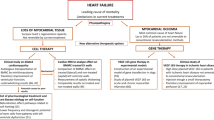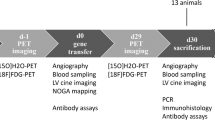Abstract
The past decade has represented a period of high expectations for cardiovascular gene transfer on the basis of the findings from preclinical experiments and promising early clinical results. Yet, randomized studies have not demonstrated similar results. Do these poor results mean that gene transfer for ischemic cardiovascular disease has failed in its promise, or do they merely signify the inherent challenges of a pioneering field? In this paper we briefly review the clinical experience of gene transfer for ischemic cardiovascular disease and propose future directions for research.
This is a preview of subscription content, access via your institution
Access options
Subscribe to this journal
Receive 12 print issues and online access
$209.00 per year
only $17.42 per issue
Buy this article
- Purchase on Springer Link
- Instant access to full article PDF
Prices may be subject to local taxes which are calculated during checkout
Similar content being viewed by others
References
Scandinavian Simvastatin Survival Study Group (1994) Randomised trial of cholesterol lowering in 4444 patients with coronary heart disease: the Scandinavian Simvastatin Survival Study (4S). Lancet 344: 1383–1389
Serruys PW et al. (1994) A comparison of balloon-expandable-stent implantation with balloon angioplasty in patients with coronary artery disease. Benestent Study Group. N Engl J Med 331: 489–495
Fischman DL et al. (1994) A randomized comparison of coronary-stent placement and balloon angioplasty in the treatment of coronary artery disease. Stent Restenosis Study Investigators. N Engl J Med 331: 496–501
Isner JM et al. (2001) Assessment of risks associated with cardiovascular gene therapy in human subjects. Circ Res 89: 389–400
Nabel EG et al. (1989) Recombinant gene expression in vivo within endothelial cells of the arterial wall. Science 244: 1342–1344
Wilson JM et al. (1989) Implantation of vascular grafts lined with genetically modified endothelial cells. Science 244: 1344–1346
Simari R et al. (1996) Regulation of cellular proliferation and intimal formation following balloon injury in atherosclerotic rabbit arteries. J Clin Invest 98: 225–235
Yanagisawa-Miwa A et al. (1992) Salvage of infarcted myocardium by angiogenic action of basic fibroblast growth factor. Science 257: 1401–1403
Cross MJ and Claesson-Welsh L (2001) FGF and VEGF function in angiogenesis: signalling pathways, biological responses and therapeutic inhibition. Trends Pharmacol Sci 22: 201–207
Tsurumi Y et al. (1996) Direct intramuscular gene transfer of naked DNA encoding vascular endothelial growth factor augments collateral development and tissue perfusion. Circulation 94: 3281–3290
Isner JM et al. (1996) Clinical evidence of angiogenesis after arterial gene transfer of phVEGF165 in patient with ischaemic limb. Lancet 348: 370–374
Baumgartner I et al. (1998) Constitutive expression of phVEGF165 after intramuscular gene transfer promotes collateral vessel development in patients with critical limb ischemia. Circulation 97: 1114–1123
Baumgartner I et al. (2000) Lower-extremity edema associated with gene transfer of naked DNA encoding vascular endothelial growth factor. Ann Intern Med 132: 880–884
Isner JM et al. (1998) Treatment of thromboangiitis obliterans (Buerger's disease) by intramuscular gene transfer of vascular endothelial growth factor: preliminary clinical results. J Vasc Surg 28: 964–973
Shyu KG et al. (2003) Intramuscular vascular endothelial growth factor gene therapy in patients with chronic critical leg ischemia. Am J Med 114: 85–92
Makinen K et al. (2002) Increased vascularity detected by digital subtraction angiography after VEGF gene transfer to human lower limb artery: a randomized, placebo-controlled, double-blinded phase II study. Mol Ther 6: 127–133
Rajagopalan S et al. (2002) Phase I study of direct administration of a replication deficient adenovirus vector containing the vascular endothelial growth factor cDNA (CI-1023) to patients with claudication. Am J Cardiol 90: 512–516
Rajagopalan S et al. (2003) Regional angiogenesis with vascular endothelial growth factor in peripheral arterial disease: a phase II randomized, double-blind, controlled study of adenoviral delivery of vascular endothelial growth factor 121 in patients with disabling intermittent claudication. Circulation 108: 1933–1938
Comerota AJ et al. (2002) Naked plasmid DNA encoding fibroblast growth factor type 1 for the treatment of end-stage unreconstructible lower extremity ischemia: preliminary results of a phase I trial. J Vasc Surg 35: 930–936
Morishita R et al. (2004) Safety evaluation of clinical gene therapy using hepatocyte growth factor to treat peripheral arterial disease. Hypertension 44: 203–209
Rajagopalan S et al. (2004) Design of the Del-1 for therapeutic angiogenesis trial (DELTA-1), a phase II multicenter, double-blind, placebo-controlled trial of VLTS-589 in subjects with intermittent claudication secondary to peripheral arterial disease. Hum Gene Ther 15: 619–24
Laitinen M et al. (1998) Adenovirus-mediated gene transfer to lower limb artery of patients with chronic critical leg ischemia. Hum Gene Ther 9: 1481–1486
Freedman SB et al. (2002) Plasma vascular endothelial growth factor (VEGF) levels after intramuscular and intramyocardial gene transfer of VEGF-1 plasmid DNA. Hum Gene Ther 13: 1595–1603
Losordo DW et al. (1998) Gene therapy for myocardial angiogenesis: initial clinical results with direct myocardial injection of phVEGF165 as sole therapy for myocardial ischemia. Circulation 98: 2800–2804
Symes JF et al. (1999) Gene therapy with vascular endothelial growth factor for inoperable coronary artery disease. Ann Thorac Surg 68: 830–836
Vale PR et al. (2000) Left ventricular electromechanical mapping to assess efficacy of phVEGF165 gene transfer for therapeutic angiogenesis in chronic myocardial ischemia. Circulation 102: 965–974
Sarkar N et al. (2001) Effects of intramyocardial injection of phVEGF-A165 as sole therapy in patients with refractory coronary artery disease—12-month follow-up: angiogenic gene therapy. J Intern Med 250: 373–381
Kolsut P et al. (2003) Gene therapy of coronary artery disease with phvegf165—early outcome. Kardiol Pol 59: 373–384
Huwer H et al. (2001) Simultaneous surgical revascularization and angiogenic gene therapy in diffuse coronary artery disease. Eur J Cardiothorac Surg 20: 1128–134
Lathi KG et al. (2001) Gene therapy with vascular endothelial growth factor for inoperable coronary artery disease: anesthetic management and results. Anesth Analg 92: 19–25
Vale PR et al. (1999) Catheter-based myocardial gene transfer utilizing nonfluoroscopic electromechanical left ventricular mapping. J Am Coll Cardiol 34: 246–254
Vale PR et al. (2001) Randomized, single-blind, placebo-controlled pilot study of catheter-based myocardial gene transfer for therapeutic angiogenesis using left ventricular electromechanical mapping in patients with chronic myocardial ischemia. Circulation 103: 2138–2143
Losordo DW et al. (2002) Phase 1/2 placebo-controlled, double-blind, dose-escalating trial of myocardial vascular endothelial growth factor 2 gene transfer by catheter delivery in patients with chronic myocardial ischemia. Circulation 105: 2012–2018
Losordo DW and Dimmeler S (2004) Therapeutic angiogenesis and vasculogenesis for ischemic disease. Part I: angiogenic cytokines. Circulation 109: 2487–2491
Rosengart TK et al. (1999) Angiogenesis gene therapy: phase I assessment of direct intramyocardial administration of an adenovirus vector expressing VEGF121 cDNA to individuals with clinically significant severe coronary artery disease. Circulation 100: 468–474
Giordano FJ et al. (1996) Intracoronary gene transfer of fibroblast growth factor-5 increases blood flow and contractile function in an ischemic region of the heart. Nat Med 2: 534–539
Grines C et al. (2002) Angiogenic gene therapy (AGENT) trial in patients with stable angina pectoris. Circulation 105: 1291–1297
Grines CL et al. for the Angiogenic GENe Therapy (AGENT-2) Study Group (2003) A randomized, double-blind, placebo-controlled trial of Ad5FGF-4 gene therapy and its effect on myocardial perfusion in patients with stable angina. J Am Coll Cardiol 42: 1339–1347
Ueda H et al. (1999) Gene transfection of hepatocyte growth factor attenuates reperfusion injury in the heart. Ann Thorac Surg 67: 1726–1731
Zhong J et al. (2003) Neovascularization of ischemic tissues by gene delivery of the extracellular matrix protein Del-1. J Clin Invest 112: 30–41
Shyu KG et al. (2002) Intramyocardial injection of naked DNA encoding HIF-1α/VP16 hybrid to enhance angiogenesis in an acute myocardial infarction model in the rat. Cardiovasc Res 54: 576–583
Green LA et al. (2002) Indirect monitoring of endogenous gene expression by positron emission tomography (PET) imaging of reporter gene expression in transgenic mice. Mol Imaging Biol 4: 71–81
Wu JC et al. (2002) Optical imaging of cardiac reporter gene expression in living rats. Circulation 105: 1631–1634
Wu JC et al. (2004) Molecular imaging of the kinetics of vascular endothelial growth factor gene expression in ischemic myocardium. Circulation 110: 685–691
Peng KW et al. (2002) Non-invasive in vivo monitoring of trackable viruses expressing soluble marker peptides. Nat Med 8: 527–531
Baker AH (2004) Designing gene delivery vectors for cardiovascular gene therapy. Prog Biophys Mol Biol 84: 279–299
Losordo DW and Dimmeler S (2004) Therapeutic angiogenesis and vasculogenesis for ischemic disease: part II: cell-based therapies. Circulation 109: 2692–2697
Ikeda Y et al. (2004) Development of angiogenic cell and gene therapy by transplantation of umbilical cord blood with vascular endothelial growth factor gene. Hypertens Res 27: 119–128
Askari A et al. (2004) Cellular, but not direct, adenoviral delivery of vascular endothelial growth factor results in improved left ventricular function and neovascularization in dilated ischemic cardiomyopathy. J Am Coll Cardiol 43: 1908–1914
Iwaguro H et al. (2002) Endothelial progenitor cell vascular endothelial growth factor gene transfer for vascular regeneration. Circulation 105: 732–738
Author information
Authors and Affiliations
Corresponding author
Ethics declarations
Competing interests
Robert D Simari is an investigator in the AGENT 3 study (sponsored by Berlex Pharmaceuticals) and an investigator and a steering committee member in the GENASIS study (sponsored by Corautus Inc.)
Glossary
- RUTHERFORD CLASS
-
Rutherford grading is based on clinical findings of limb ischemia (grade I, claudication; grade II, rest pain; grade III, tissue loss)
Rights and permissions
About this article
Cite this article
Pislaru, S., Simari, R. Gene transfer for ischemic cardiovascular disease: is this the end of the beginning or the beginning of the end?. Nat Rev Cardiol 2, 138–144 (2005). https://doi.org/10.1038/ncpcardio0136
Received:
Accepted:
Issue Date:
DOI: https://doi.org/10.1038/ncpcardio0136
This article is cited by
-
Advances in Gene-Based Therapy for Heart Failure
Journal of Cardiovascular Translational Research (2008)
-
Cardiac cell-repair therapy: clinical issues
Nature Clinical Practice Cardiovascular Medicine (2006)



